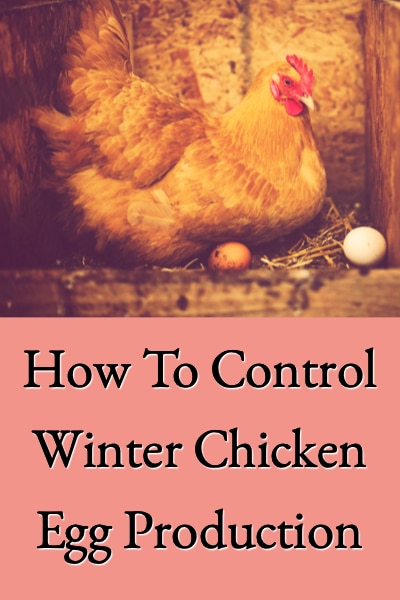
This happens because most chickens naturally decrease egg production during the colder months. However, with a little knowledge and preplanning, a flock can be controlled to produce eggs year-round.
After a chicken’s nutritional needs are met, the two most critical factors controlling chicken egg production are day length and genetic makeup.
So over the years, humans have learned to manipulate these factors to consistently obtain eggs. Depending on your chicken-keeping priorities, you can use these methods to control your flock’s winter egg production too!
How To Control Winter Chicken Egg Production
Choose Egg-Laying Breeds
Increasing day length in the springtime signals a hen to start laying eggs, incubate eggs (go broody) and raise baby chicks. Conversely, shortening day length in the fall signals her to slow down on egg production, molt (replace feathers), and renew nutritional stores.
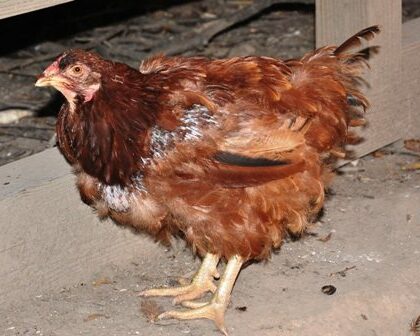
Molting Chicken
This natural cycle favors the survival of offspring, but negatively impacts egg production. Since chickens don’t produce eggs when they are broody, raising chicks, or molting (for more on molting click HERE), humans have been breeding hens to minimize these characteristics for hundreds of years. The resulting specialized egg-laying breeds, like Leghorns, Golden Comets, and Sex Links, maximize egg production, minimize broodiness and molt quickly.
A natural method of controlling winter egg production then is to choose modern egg-laying breeds for the flock as opposed to choosing more traditional dual-purpose (bred for meat and eggs) breeds. Traditional chickens that can be used for both meat and eggs tend to follow the natural cycle described above and cease egg production in winter.
Egg-laying breeds typically start laying at 5 – 6 months of age, skip the broody, chick-raising, and molt cycle, and lay continuously for 12 – 14 months in their first year. Then they slow down or stop egg production completely as they go through a major molt for two to three months.
Those wanting to obtain eggs year-round naturally can take advantage of the characteristics of the modern egg layers. New chicks can be started each spring so that they begin laying in the fall when last year’s chickens start their first molt. Generally, these pullets will lay through their first winter without any added light and will start supplying eggs when last year’s birds begin molting.
When using the egg production model described above, older chickens are usually culled when they start their second molting cycle. That’s because although the specialized egg-laying breeds lay heavily for their first two years, they typically slow significantly after that and younger birds are much more productive.
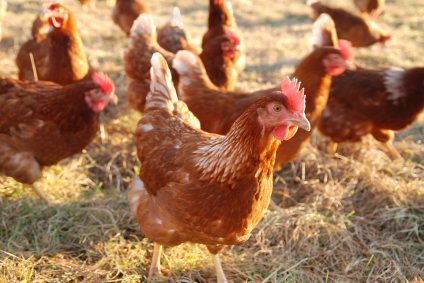
Golden Comet Hens (Egg-Laying Breed)
Control Chicken Winter Egg Production With Artificial Light
Another method chicken keepers can use to obtain eggs throughout winter is to add artificial light to increase the day length. A chicken needs approximately 14 hours of daylight to stimulate its pituitary gland such that its ovaries release an egg. During the winter in the US, the average amount of daylight is about 9.5 hours, so there is insufficient light to cause an egg to be released. But, if artificial light is supplied such that chickens receive 14 – 16 hours of light every day, many hens will produce throughout winter. Even dual-purpose birds that have completed a fall molt will typically start laying again in winter when artificial light is supplied.
If artificial light is used, natural lighting should be supplemented when day lengths fall to 15 hours in the fall. Chickens are very sensitive to changes in day length, so if even one day of artificially extended light is missed, they may cease egg production. For this reason, automatic timers are highly recommended when extending the day length.
Chickens do need 6 – 8 hours of darkness in each 24-hour period to allow them to rest and keep their immune systems healthy. So, putting a light on a timer that automatically turns on and off at specific times is a convenient method for lighting a coop. For both chicken health and cost reasons, it’s not recommended that lights be left on all night. A timer is an inexpensive and easy way to ensure that laying hens receive the light they require to produce eggs while minimizing electrical bills.
Supplemental light should be added in the morning hours, prior to dawn. It should not be added at the end of the day, because chickens may get caught off the roost at night. They cannot find their roosts in the dark because they have poor night vision and may become confused, stressed, or even injured. By adding extra light in the morning rather than evening, chickens will naturally roost with the sun’s setting.
To provide 15 hours of light each day, calculate backward from sunset to determine how many hours the light should be on. For example, if the goal is to provide 15 hours of light during the day when sunset is at 6:00 PM and sunrise at 7:00 AM, the timer should be set to turn the light on at 3:00 AM (6:00 PM – 15 hours = 3:00 AM) and off at 7:00 AM. The timer will need to be adjusted every few weeks to keep up with seasonal changes.
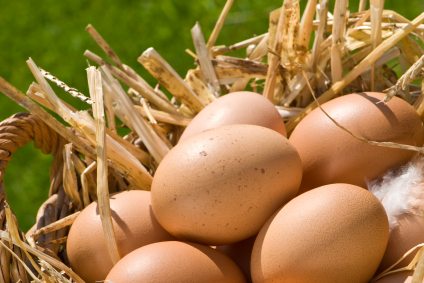
Freshly Laid Eggs
Types of Artificial Lights
Another item to consider when setting up artificial light is the type of bulb and wattage. Until recently, incandescent or fluorescent bulbs were the only options. Fluorescent bulbs are less expensive to operate than incandescent, but are more expensive to install, harder to maintain, and it’s difficult to regulate light intensity with fluorescents. If using fluorescent, a ‘warm’ wavelength needs to be used to mimic sunlight. ‘Cool’ wavelength bulbs, like those commonly used in offices, will not stimulate the hens’ reproductive cycle.
Low-wattage bulbs should provide enough light to make hens think they are getting their daily requirement of light and keep them producing. For example, a 40-watt incandescent bulb placed seven feet above the coop floor is usually adequate for 120 square feet (a 10’ x 12’ coop).
Adding a hot, breakable incandescent or fluorescent bulb to a coop full of chickens and dry straw or pine shavings is obviously a safety concern. Light bulbs can be a fire hazard and a small drop of water or a bird flapping its wings can cause one to shatter. When adding artificial light using bulbs, it’s critical that they be installed and protected correctly to prevent accidental fires or injuries.
A newer and far safer alternative to incandescent or fluorescent bulbs in the chicken coop is LED light panels. LED panels are one of the most efficient sources of light on the market today and are not easily broken. Small panels can provide light equivalent to a 40-watt incandescent bulb but require only about 2 watts of power.

LED Light w/Timer
For the ultimate in safety, efficiency, and convenience, chicken coop controllers are now available that turn on and off an LED light panel to provide artificial light for a specified time, open the coop door at sunrise, close the coop door at sunset, and prevent the door from opening if it’s too cold outside.
Artificial Lighting Concerns
Some chicken owners are concerned that adding artificial light in winter is harmful to their chickens and continued egg production will wear them out. However, there is no scientific evidence that supplemental lighting is detrimental or will decrease a hen’s lifespan. Chickens need to molt periodically to replace worn-out feathers and rebuild nutritional stores. But, as long as birds are fed properly and allowed to molt every 12 to 18 months, hens can safely lay throughout winter.
Adding artificial light too soon; however, can negatively affect young pullets that are just getting ready to lay. If pullets are exposed to too much artificial light too soon, it can stimulate them to start producing eggs before their bodies are ready. So, supplemental lighting should not be applied to female chicks until they are at least 16 weeks of age.
There are also rumors that hens will “run out” of eggs if they produce eggs year-round. But each hen is born with the ability to lay many thousands of eggs, which would take her years of egg production to complete. Hens really stop laying from old age – not because they run out of eggs.
Planning To Control Winter Egg Production
By knowing the basics about chicken egg production, plans can be made to produce the desired number of eggs in winter. If the maximum number of eggs is desired, then egg-laying breed chicks would be started each spring, artificial lighting used, and older chickens culled each fall as molting began.
Using natural lighting, egg-laying breeds, and culling less aggressively will produce far fewer eggs than in the model above. However, it should still yield a continuous supply of winter eggs. For those wanting to add dual-purpose breeds, they will typically produce eggs in winter when artificial light is supplied, but won’t if only natural lighting is being used.
Although there are many issues to consider when implementing a program to provide backyard eggs through winter, most chicken keepers find it to be a rewarding investment. By properly managing the type of chickens and light in your coop, you will be rewarded with a year-round supply of tasty eggs.
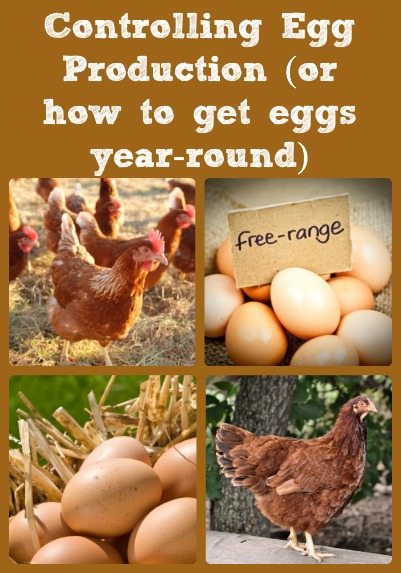
Patrick says
We can’t wait to get chickens! I never knew you could control the egg production like this!
Leigh says
This is fascinating! I never thought to try and control the eggs.